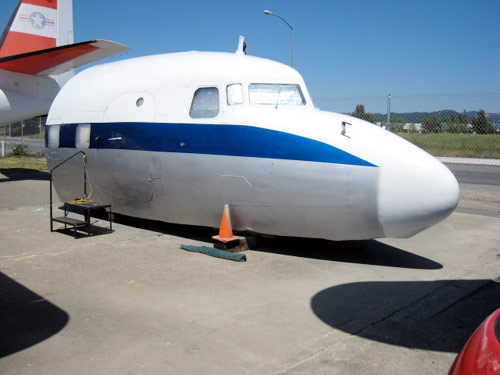A brief history of our DC-6 Cockpit
MSN 44087 rolled off the Douglas Aircraft Company assembly line on Oct. 14, 1953 for delivery to Swissair who flew the aircraft on its international routes. We have pictures of this aircraft at the old Tokyo Haneda International Airport.
| Sept 1962 | Swissair leased the aircraft to Finlantic |
| Jan 1964 | Returned to Swissair in May 1963 and sold to Olympic Airways |
| Aug 1972 | Concare Aviation of Canada acquired the aircraft and converted it to a forest fire tanker |
| May 1973 | Sold to Conair Aviation |
| June 1973 | Sold to Rosenbalm Aviation |
| Mar 1975 | Sold Tanker 46, as the aircraft was now known, to Sis-Q Flying Service |
| May 1985 | Macavia International Corp. acquired tanker 46 |
Sometime between then and 1991 the aircraft was parked and stored at Santa Rosa. It then was sold to several aircraft brokers, but not flown. In Dec. 1997 the aircraft was broken up and sold for scrap with the exception of the cockpit section which was saved.
The Pacific Coast Air Museum acquired the cockpit section but until Aug. 2005 little or no work was done to restore the cockpit. The cockpit section sat out exposed to the weather for many years and is in bad shape. Vandals and souvenir hunters have removed most of the instruments, lights, etc. from the cockpit and we are finding it difficult to find replacements.
General History of the DC-6
The DC-6 was a development of the DC-4 Skymaster. The DC-6 used the same wing as the -4 but had a pressurized fuselage that was lengthened by just over 2 meters and used larger engines. Although initial development of the DC-6 occurred during World War II, it was carried on after the war and targeted the post war airlines as customers and entered service in April of 1947 with American Airlines.
During 1948, the Douglas company developed a cargo version of the aircraft with an even longer fuselage and larger engines which was named the DC-6A. This was followed by a similar passenger transport version called the DC-6B. Military versions of the aircraft were called the C-118 Liftmaster.
The 29th C-118A off the line was given a VIP interior for President Truman and designated a VC-118 and named “The Independence”. Multiple versions of the aircraft were produced for the U.S. Navy and were called R6D-1 and R6D-1Z, the latter with VIP interiors. DC-6 type aircraft were used by most branches of the military over the years.
The DC-6 proved itself to be a reliable and capable transport that is considered the pinnacle of piston propelled transport aircraft. Although displaced by the jet aircraft developed in the 50´s, the DC´s continued on in the lower echelons of air transport and many are still in service today.
DC-6 Cockpit Specifications
Length
105 ft 7 in (32.18 m)
Wingspan
117 ft 6 in (35.81 m)
Height
28 ft 8 in (8.74 m)
Wing area
1,463 sq ft (135.91 sq m)
Maximum takeoff weight
107,000 lb (48,534 kg)
Empty weight
55,357 lb (25,110 kg)
Three crew (pilot, copilot, flight engineer) and up to 102 passengers depending upon configuration
Cruising Speed
315 mph
Service Ceiling
25,000 ft
Range with max payload
3,005 miles
Four 2,500HP Pratt & Whitney R-2800-CB17 Double Wasp Radial Engines
Position Open

